Mybatis练习(按值单条件查询)
创始人
2024-03-14 14:22:37
0次
Mybatis练习
安装MybatisX
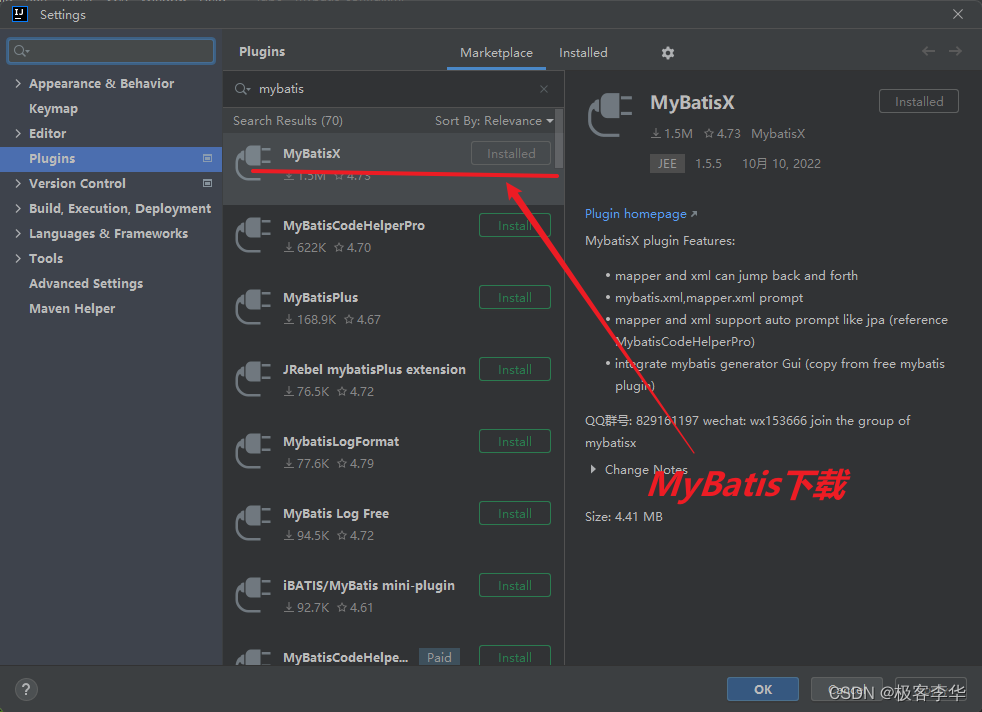
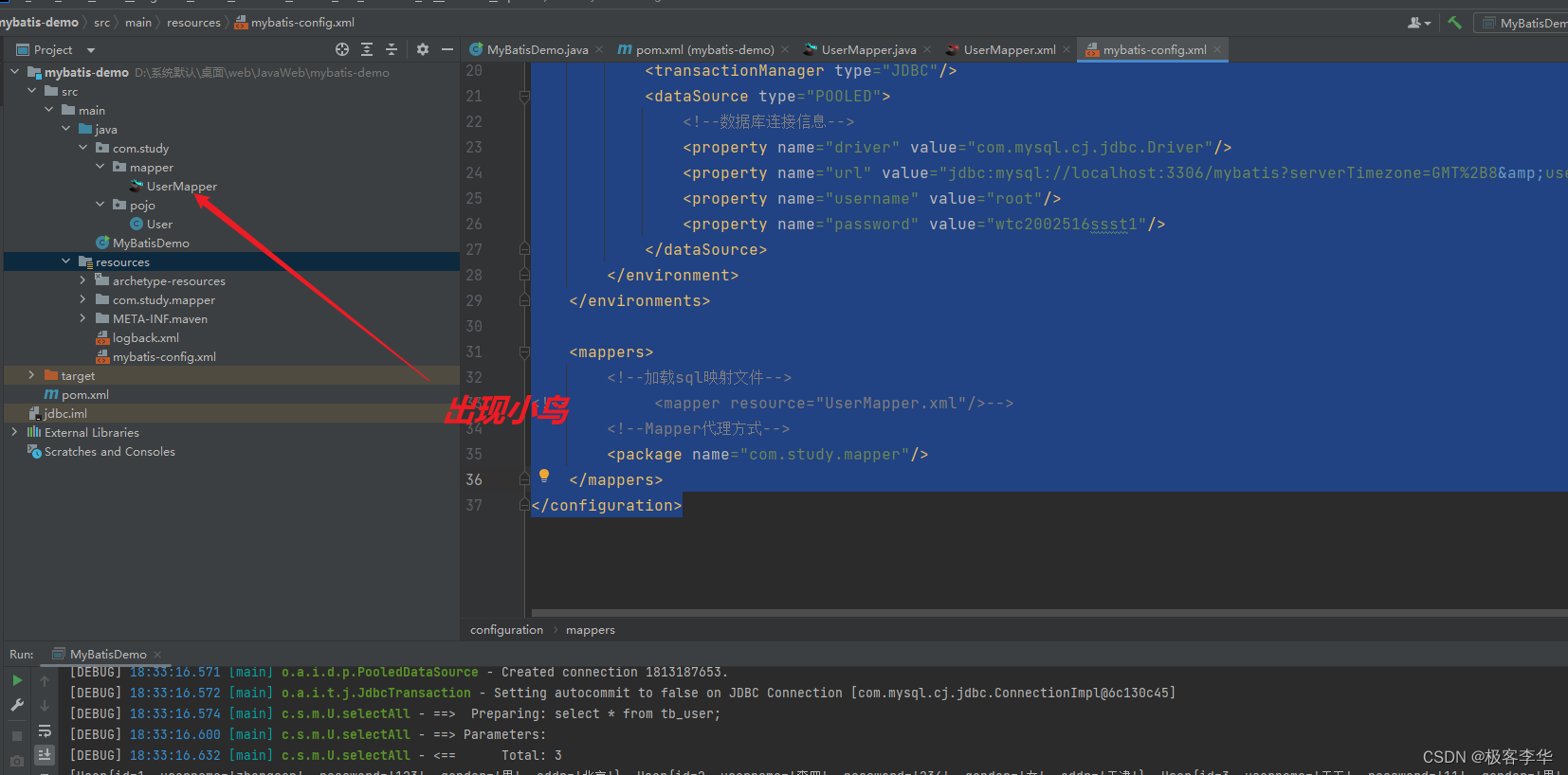
接下来我们就使用Mybatis完成品牌数据的增删改查操作。以下是我们要完成功能列表:
- 查询
- 查询所有数据
- 查询详情
- 条件查询
- 添加
- 修改
- 修改全部字段
- 修改动态字段
- 删除
- 删除一个
- 批量删除
创建数据库
-
数据库表(tb_brand)及数据准备
-- 删除tb_brand表 drop table if exists tb_brand; -- 创建tb_brand表 create table tb_brand (-- id 主键id int primary key auto_increment,-- 品牌名称brand_name varchar(20),-- 企业名称company_name varchar(20),-- 排序字段ordered int,-- 描述信息description varchar(100),-- 状态:0:禁用 1:启用status int ); -- 添加数据 insert into tb_brand (brand_name, company_name, ordered, description, status) values ('三只松鼠', '三只松鼠股份有限公司', 5, '好吃不上火', 0),('华为', '华为技术有限公司', 100, '华为致力于把数字世界带入每个人、每个家庭、每个组织,构建万物互联的智能世界', 1),('小米', '小米科技有限公司', 50, 'are you ok', 1); -
创建Brand实体类
在
com.study.pojo包下创建 Brand 实体类。
package com.study.pojo;public class Brand {// id 主键private Integer id;// 品牌名称private String brandName;// 企业名称private String companyName;// 排序字段private Integer ordered;// 描述信息private String description;// 状态:0:禁用 1:启用private Integer status;public Integer getId() {return id;}public void setId(Integer id) {this.id = id;}public String getBrandName() {return brandName;}public void setBrandName(String brandName) {this.brandName = brandName;}public String getCompanyName() {return companyName;}public void setCompanyName(String companyName) {this.companyName = companyName;}public Integer getOrdered() {return ordered;}public void setOrdered(Integer ordered) {this.ordered = ordered;}public String getDescription() {return description;}public void setDescription(String description) {this.description = description;}public Integer getStatus() {return status;}public void setStatus(Integer status) {this.status = status;}@Overridepublic String toString() {return "Brand{" +"id=" + id +", brandName='" + brandName + '\'' +", companyName='" + companyName + '\'' +", ordered=" + ordered +", description='" + description + '\'' +", status=" + status +'}';}
}编写接口方法
在 com.study.mapper 包写创建名为 BrandMapper 的接口。并在该接口中定义 List 方法。
package com.study.mapper;import com.study.pojo.Brand;import java.util.List;public interface BrandMapper {/*** 查询所有*/List selectAll();
}
编写BrandMapper.xml
在 reources 下创建 com/study/mapper 目录结构,并在该目录下创建名为 BrandMapper.xml 的映射配置文件
编写logback.xml和mybatis-config.xml
这里参考文章Mapper代理开发
编写测试方法
- 编写测试用例
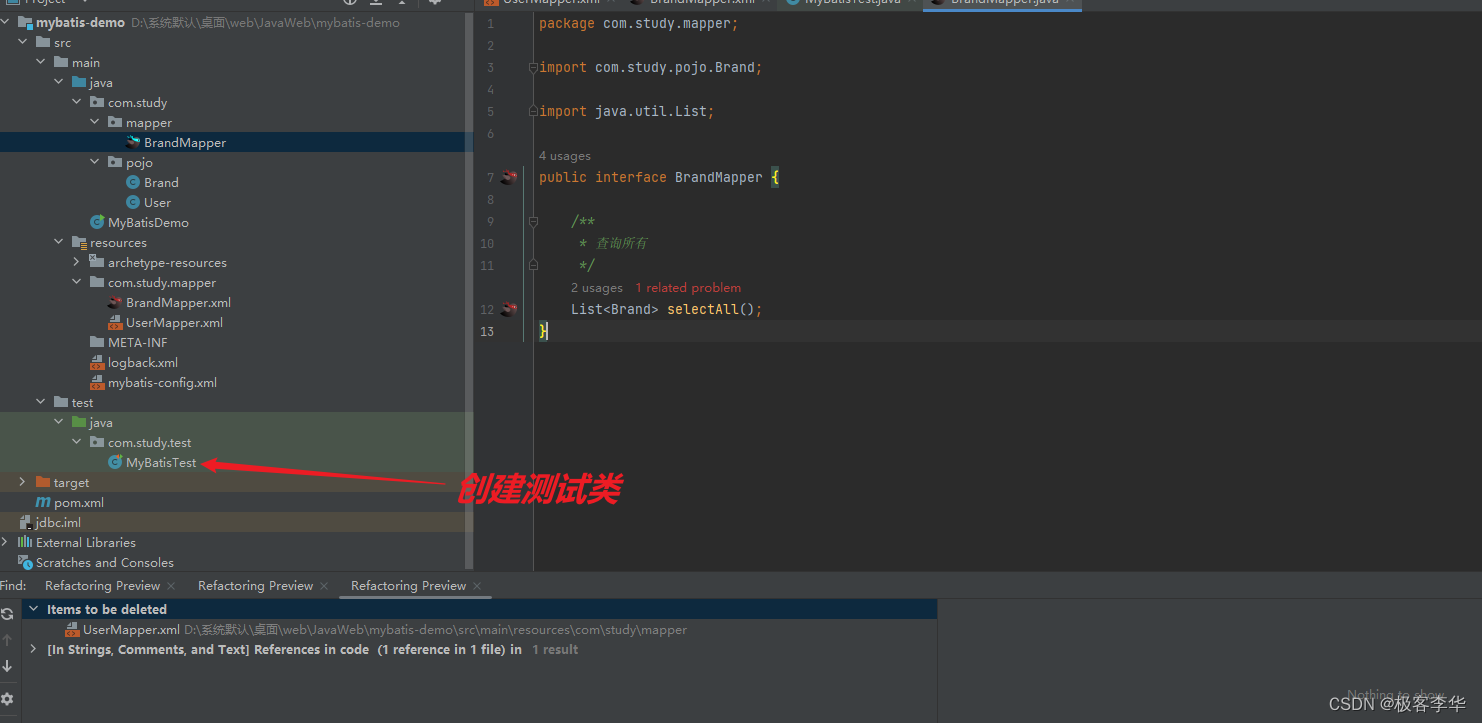
package com.study.test;import com.study.mapper.BrandMapper;
import com.study.pojo.Brand;
import org.apache.ibatis.io.Resources;
import org.apache.ibatis.session.SqlSession;
import org.apache.ibatis.session.SqlSessionFactory;
import org.apache.ibatis.session.SqlSessionFactoryBuilder;
import org.junit.Test;import java.io.IOException;
import java.io.InputStream;
import java.util.List;public class MyBatisTest {@Testpublic void testSelectAll() throws IOException {//1. 获取SqlSessionFactoryString resource = "mybatis-config.xml";InputStream inputStream = Resources.getResourceAsStream(resource);SqlSessionFactory sqlSessionFactory = new SqlSessionFactoryBuilder().build(inputStream);//2. 获取SqlSession对象SqlSession sqlSession = sqlSessionFactory.openSession();//3. 获取Mapper接口的代理对象BrandMapper brandMapper = sqlSession.getMapper(BrandMapper.class);//4. 执行方法List brands = brandMapper.selectAll();System.out.println(brands);//5. 释放资源sqlSession.close();}
}
运行结果讲解

根据id来查询
-
编写接口方法:Mapper接口
-
参数:id
查看详情就是查询某一行数据,所以需要根据id进行查询。而id以后是由页面传递过来。
-
结果:Brand
根据id查询出来的数据只要一条,而将一条数据封装成一个Brand对象即可
-
-
编写SQL语句:SQL映射文件
-
执行方法、进行测试
编写接口方法
在 BrandMapper 接口中定义根据id查询数据的方法
/*** 查看详情:根据Id查询*/
Brand selectById(int id);
编写SQL语句
在 BrandMapper.xml 映射配置文件中编写 statement,使用 resultMap 而不是使用 resultType
注意:上述SQL中的 #{id}先这样写,一会我们再详细讲解
编写测试方法
在 test/java 下的 com.study.mapper 包下的 MybatisTest类中 定义测试方法
@Test
public void testSelectById() throws IOException {//接收参数,该id以后需要传递过来int id = 1;//1. 获取SqlSessionFactoryString resource = "mybatis-config.xml";InputStream inputStream = Resources.getResourceAsStream(resource);SqlSessionFactory sqlSessionFactory = new SqlSessionFactoryBuilder().build(inputStream);//2. 获取SqlSession对象SqlSession sqlSession = sqlSessionFactory.openSession();//3. 获取Mapper接口的代理对象BrandMapper brandMapper = sqlSession.getMapper(BrandMapper.class);//4. 执行方法Brand brand = brandMapper.selectById(id);System.out.println(brand);//5. 释放资源sqlSession.close();
}
运行结果
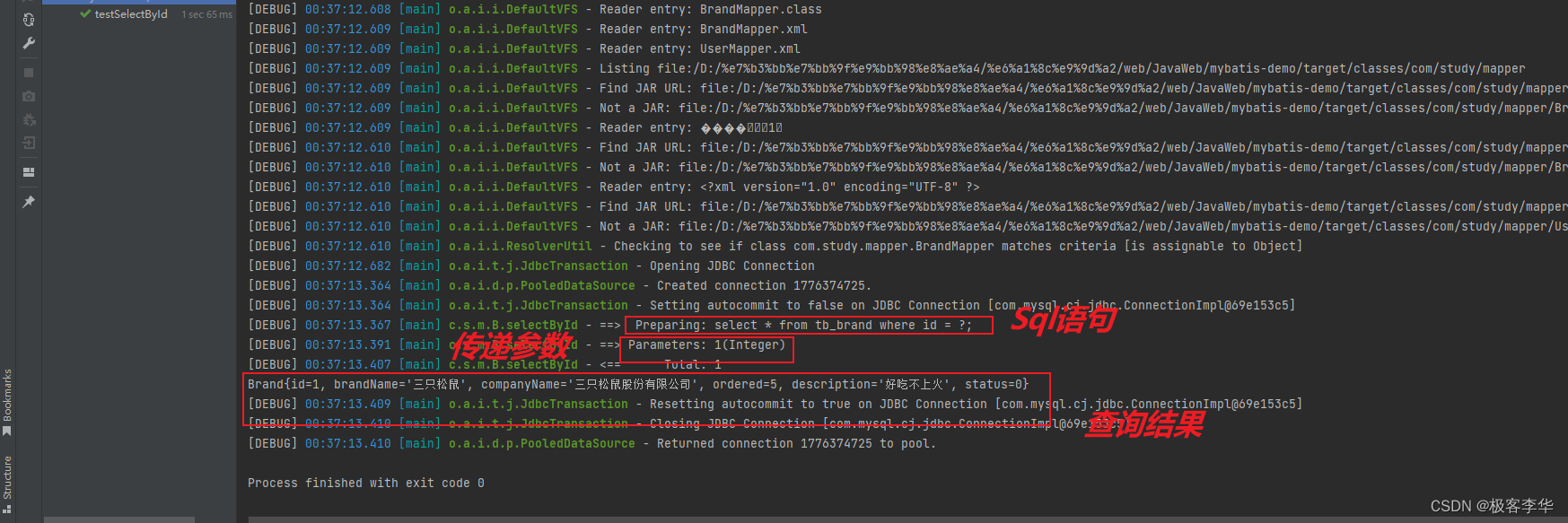
SQL语句中特殊字段处理
我们开发的时候有可能会遇到某些特殊字符,导致报错的情况发生。
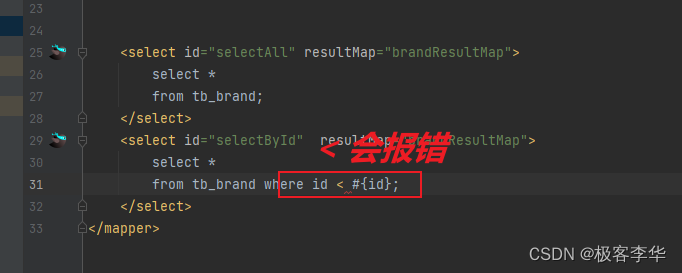
-
转义字符
下图的
<就是<的转义字符。
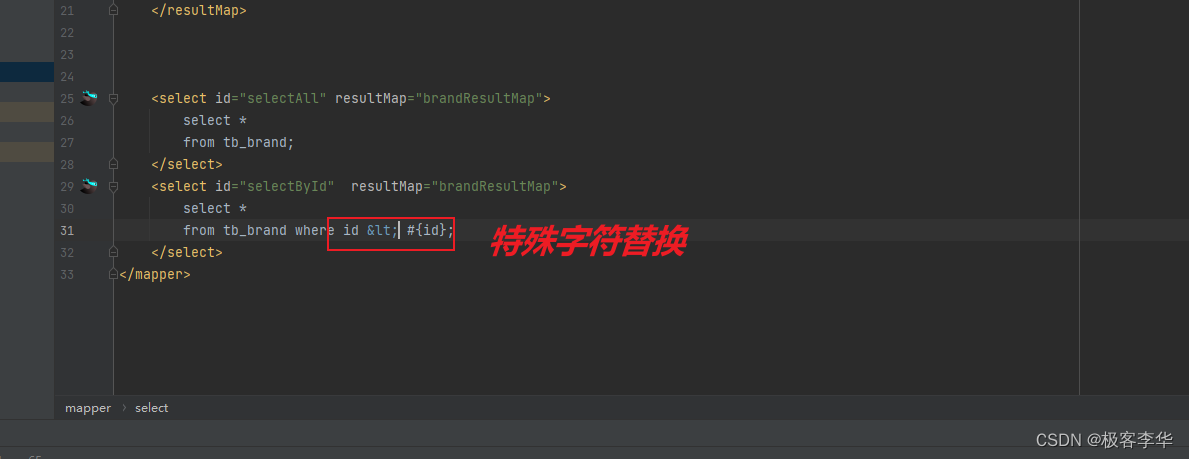
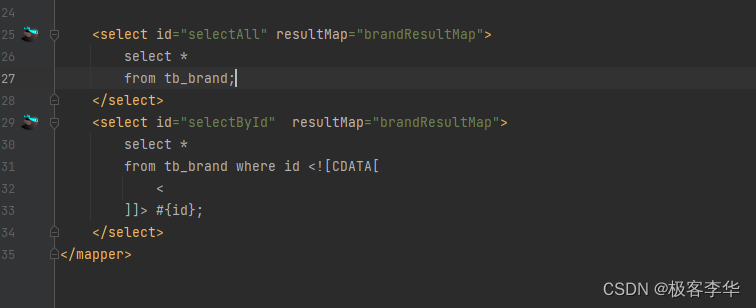
相关内容
热门资讯
汽车油箱结构是什么(汽车油箱结...
本篇文章极速百科给大家谈谈汽车油箱结构是什么,以及汽车油箱结构原理图解对应的知识点,希望对各位有所帮...
美国2年期国债收益率上涨15个...
原标题:美国2年期国债收益率上涨15个基点 美国2年期国债收益率上涨15个基...
嵌入式 ADC使用手册完整版 ...
嵌入式 ADC使用手册完整版 (188977万字)💜&#...
重大消息战皇大厅开挂是真的吗...
您好:战皇大厅这款游戏可以开挂,确实是有挂的,需要了解加客服微信【8435338】很多玩家在这款游戏...
盘点十款牵手跑胡子为什么一直...
您好:牵手跑胡子这款游戏可以开挂,确实是有挂的,需要了解加客服微信【8435338】很多玩家在这款游...
senator香烟多少一盒(s...
今天给各位分享senator香烟多少一盒的知识,其中也会对sevebstars香烟进行解释,如果能碰...
终于懂了新荣耀斗牛真的有挂吗...
您好:新荣耀斗牛这款游戏可以开挂,确实是有挂的,需要了解加客服微信8435338】很多玩家在这款游戏...
盘点十款明星麻将到底有没有挂...
您好:明星麻将这款游戏可以开挂,确实是有挂的,需要了解加客服微信【5848499】很多玩家在这款游戏...
总结文章“新道游棋牌有透视挂吗...
您好:新道游棋牌这款游戏可以开挂,确实是有挂的,需要了解加客服微信【7682267】很多玩家在这款游...
终于懂了手机麻将到底有没有挂...
您好:手机麻将这款游戏可以开挂,确实是有挂的,需要了解加客服微信【8435338】很多玩家在这款游戏...